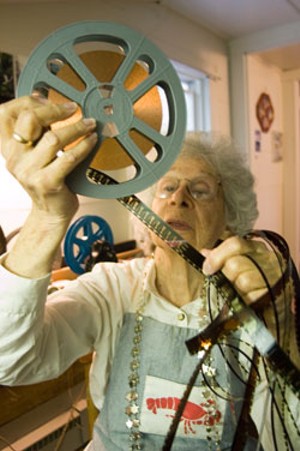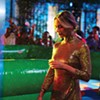Published October 24, 2007 at 6:51 p.m.
The Tuesday night crowd is young and hip at Studio STK in Burlington’s Old North End. Retro-punk hair, tattoos and skinny jeans appear among the 15 or so locals who endure plastic-molded chairs for two hours of “Secret Movie Night,” hosted by filmmaker and STK web designer Will Skolochenko.
On this muggy night, though, a different generation is presiding. Dressed in white cotton, her head in a turban-style wrap, a diminutive 86-year-old woman named Cecile Starr rises to introduce her favorite short films. “Most of these come from before 1970,” she says, sounding confident and slightly patrician, like a former professor. “But give them a look, and maybe you’ll find they were doing some things you like back then.”
For the past 60 years or so, Starr has been involved with film in some way or another — as a scholar, creator, preservationist and distributor. Her conversation is studded with references to personal encounters with directors such as Roberto Rossellini and Louis Malle. Brian De Palma (Scarface) was an unregistered student in her film course at Columbia when he was in his teens, as was Peter Bogdanovich (The Last Picture Show).
Years later, Starr wrote an article recollecting these two young men who were driven to conquer Hollywood. But her own interest lay, and still lies, elsewhere: with the underdog. “I mistrust power in all its forms. Power is abusive by definition,” she muses in an interview in her Old North End home.
In Hollywood, power belongs to the directors of profitable feature-length films. Starr’s passion is the less marketable shorts that she has helped preserve and distribute. She’s written about them, too, in books such as Experimental Animation (1976) and Discovering the Movies (1972).
Not surprisingly, that’s what she’s showing the young folks at Secret Movie Night. Starr’s first pick is an abstract animation from the 1920s. On the screen, white squiggles flap like birds and transform themselves sinuously into new shapes, timed to music. She explains afterward that the film’s creator, the German Oskar Fischinger, tried to work in Hollywood for Disney, “but he didn’t get along with them very well.”
Next comes a documentary short depicting a day at the racetrack, by Hans Richter. With its rapid-fire montage and double exposures, the film would look experimental to the average audience today. In 1929, when it was made, “these were shown in theaters,” Starr says, recalling the then-standard practice of showing short films before the commercial feature.
The following film, by New Zealand animator Len Lye, could easily be mistaken for a piece of ’60s psychedelia. Its colors are DayGlo, searing the eye, and its images surreal: A man’s form bats a tennis ball, while an animated landscape swirls behind him. Only the jazzy music suggests an earlier era. In fact, “Rainbow Dance” is a film Lye made in 1936, as a promotion for the British Post Office.
For young filmmakers and graphic artists who consider themselves way out there in 2007, these short films could be a rude awakening: People were already doing this stuff. But they’re also inspiring — and enlightening. A film called “In the Street,” by Helen Levitt, is a 1940s document of life in the working-class neighborhoods of New York. Unlike most Hollywood versions of the period, it teems with the life of a multiracial metropolis: Kids dance in unleashed hydrants, trick-or-treat, pelt each other with socks full of flour.
When someone in the STK audience asks what that white stuff is, Starr’s husband of 50 years, Aram Boyajian, speaks up. The soft-spoken filmmaker, playwright and poet has made a raft of TV documentaries for shows such as “20/20.” “I played this game,” he says, channeling his childhood. “Back then, every child played this game.”
Starr knows Helen Levitt. In fact, she knows or knew many of these filmmakers, and peppers her commentary with anecdotes about them. Harry Smith, for instance, the San Francisco filmmaker, folk music anthologist and mystic, was “a very strange guy.” Lye was “a wonderful human being.” Amos Vogel, who ran the influential 1960s film series Cinema 16, initially struck her as a “con man.” Closer to home, there’s Robert J. Flaherty, the director of groundbreaking doc Nanook of the North (1922), who died in Dummerston, Vermont, in 1951. Starr used to attend the film seminars held there each summer by Flaherty’s widow, Frances. Today, though, “Vermont has forgotten about the Flahertys,” she says.
Starr’s own life in Vermont is low profile. For the past 15 years, she and Boyajian have lived in a modest house around the corner from STK. They started coming here when their grown daughter got a local job. Starr showed films at the now-defunct Café No-No. She also taught at Burlington College and served on the advisory board of the Vermont International Film Festival. The couple likes to spend the dead of winter farther south — in the Big Apple.
Walking from the bus stop one day, Starr says, she came across Studio STK and ventured in. Since then, she’s volunteered to curate three installments of Secret Movie Night. On November 6, she’ll present a fourth program in honor of Boyajian’s 85th birthday, including a film he made about William Blake that features narration by Allen Ginsberg.
**************
Once Starr starts talking about the past, she doesn’t stop. But she doesn’t ramble, either. As prep for the interview, she offers a package of resumes — typed sans PC — and reprints from her journalism career, each annotated in meticulous purple script. Not so, she’s written on the press release for a 1992 honor she received, which erroneously describes her as “founder and President of Starr Films.”
Starr was born in Nashville “on Bastille Day, 1921,” she says. Raised in New Orleans, she went to Louisiana State University — “as far as my mother would let me go from home” — and befriended the future brother-in-law of journalist James Agee, whose reviews for Time and The Nation would change the course of film criticism. Later on, “I got to know Jim very, very well,” she recalls. “He was one of the first people I met in New York. That was my beginning of taking film seriously.”
Starr arrived in New York in 1941 and got a wartime job at the Australian News and Information Bureau. “I wore little earphones and typed out messages that were radioed from Australia about what was going on in the South Pacific,” she says. Captured “at the far end of Long Island,” the dispatches were mimeographed and hand-delivered to the major media outlets: “That was how news spread in the olden days. Iwo Jima — these places weren’t even on the map! We had to figure out, where the devil were these things?”
Next, Starr moved to Time, Inc. and worked on The March of Time, a series of monthly short documentaries. More and more, film became her world. “Like everyone else in the ’30s, I went to the movies twice a week and saw everything,” she says. “The wonderful Fred Astaire movies, the wonderful Busby Berkeley movies. We never dreamed that you could ever call their ghosts back. Once they left the theater, that was the end.” But in New York, Starr found films circulating among movie buffs in 16 millimeter, “legally or illegally” — the mid-century equivalent of Internet video sharing. “It was very exciting for me.”
Her excitement led to a writing job at a small magazine called Film Forum Review, then to the Saturday Review, where she wrote about 16-millimeter films and “got to know everybody.” For 10 years Starr used her column at the prestigious weekly to offer guidance to public librarians who were just starting to build film collections, after years of scorning “the pictures” as an inferior art form.
Eventually, she became a custodian of celluloid herself. “I’ve always loved short films,” Starr explains. “When I started teaching, I saw such a tremendous prejudice in favor of Hollywood-type films that I felt were often undeserving. All it needed was the name of a famous director, and you were supposed to applaud at the end.” By contrast, the experimental shorts Starr loved had become obscure. She recalls asking director Hans Richter, who’d worked with Sergei Eisenstein, for excerpts from his work to use in a documentary. “And he said, ‘Take the films, because nobody is interested in them.’ Well, I wanted to cry.” Soon she began to “take in boarders, you might say. I took in all these homeless films. It has been a great joy for me to have an excuse to see them over and over and over again.”
Most “film distributors” are divisions of multinational corporations. For Starr, distributing films is a “cottage industry, except it was in my apartment” and a labor of love, she says. Sometimes it was a physical labor, too — to distribute a feature, she had to enlist her son to carry the reels to the post office.
Many of these films were made by women, such as Levitt, Claire Parker and Mary Ellen Bute, who once had her films shown at Radio City Music Hall “on a 50-foot screen,” says Starr. In 1977, Starr wrote an article for The New York Times provocatively called “Is the Government Subsidizing Sexism in Film?” which pointed to the virtual absence of female filmmakers from federally funded exhibitions. (“The headline was not mine!” she stresses.) Not long after, with Bute and others, she founded the Women’s Indepen-dent Film Exchange.
“In the documentary, animation and experimental world, husbands and wives working together have produced some very major works,” Starr declares. Robert Flaherty, for instance, reportedly wouldn’t look at his rushes without Frances present. But Starr found that “when you relayed this information on to men, they did not accept it. They were blind to it.” Some prominent men in the film world ended up on what she called “my list of unfavorite people who made big names for themselves and didn’t do right by women they could have done better by.”
Starr is nothing if not candid. “I wrote a lot of junk,” she says of her career as a critic. “But I tried to write about and for the filmmakers. The older they got and the less they were honored, the more I tried.” She displays with pride a 1997 letter from young filmmaker Drew Klausner, thanking her for publicizing and distributing his short film. “There are so few people today that will do anything because of their sheer belief in something,” he wrote, “and it is for this alone that I’m eternally grateful to you.”
These days, Klausner — whom Starr says she’s never met — is earning his bread and butter as a digital artist on movies such as Transform-ers. For her part, Starr hasn’t seen a movie in a theater in 15 years — partly because she suffers from chemical sensitivity, which is aggravated by perfumes and sanitizers, and partly because she just isn’t interested. “I saw The Public Enemy [1931] — that really does it!” she says, explaining why she isn’t impressed with former student De Palma’s violent flicks. “When you get older, you feel, ‘I’ve already seen that.’ The films we love most, we saw when we were teenagers. They were part of our development.”
Perhaps some young viewers will have those formative experiences at Secret Movie Night. Starr has shown her shorts to much less sophisticated audiences — like elementary school — and she firmly believes that “the really important stuff can be understood by everybody.”
Info:
Secret Movie Night featuring films of Aram Boyajian, Tuesday, November 6, Studio STK, Burlington, 8 p.m. $3. Info, 657-3333.
More By This Author
About the Artist

Matthew Thorsen
Bio:
Matthew Thorsen was a photographer for Seven Days 1995-2018. Read all about his life and work here.
Matthew Thorsen was a photographer for Seven Days 1995-2018. Read all about his life and work here.
Speaking of Burlington
-

Burlington Budget Deficit Balloons to $13.1 Million
Apr 25, 2024 -

The Café HOT. in Burlington Adds Late-Night Menu
Apr 23, 2024 -

Burlington Mayor Emma Mulvaney-Stanak’s First Term Starts With Major Staffing and Spending Decisions
Apr 17, 2024 -

Totally Transfixed: A Rare Eclipse on a Bluebird Day Dazzled Crowds in Northern Vermont
Apr 10, 2024 -

Middlebury’s Haymaker Bun to Open Second Location in Burlington’s Soda Plant
Apr 9, 2024 - More »
Comments
Comments are closed.
From 2014-2020, Seven Days allowed readers to comment on all stories posted on our website. While we've appreciated the suggestions and insights, right now Seven Days is prioritizing our core mission — producing high-quality, responsible local journalism — over moderating online debates between readers.
To criticize, correct or praise our reporting, please send us a letter to the editor or send us a tip. We’ll check it out and report the results.
Online comments may return when we have better tech tools for managing them. Thanks for reading.













































